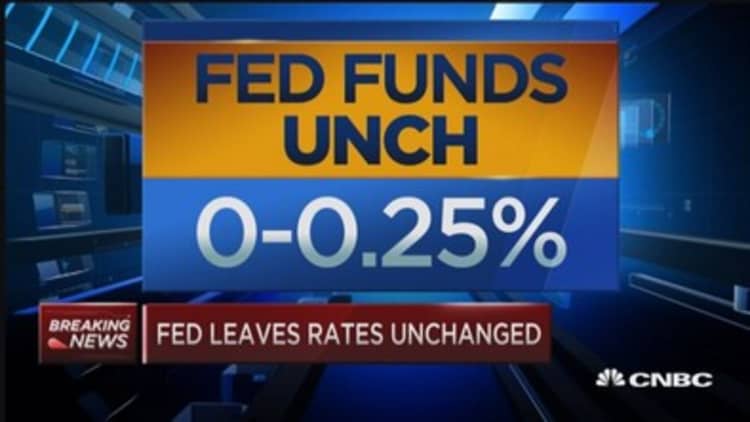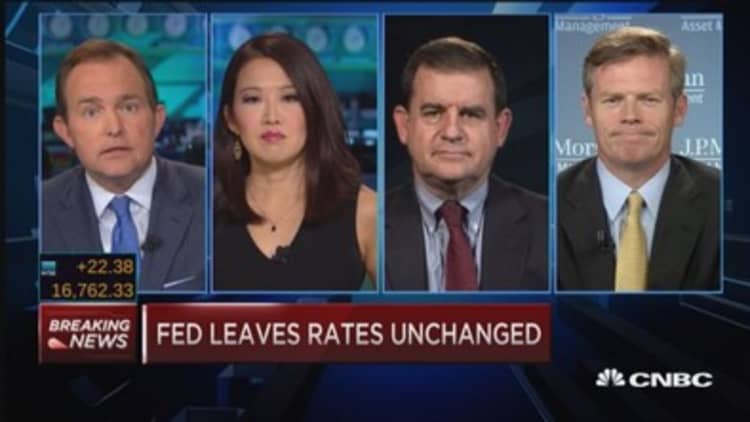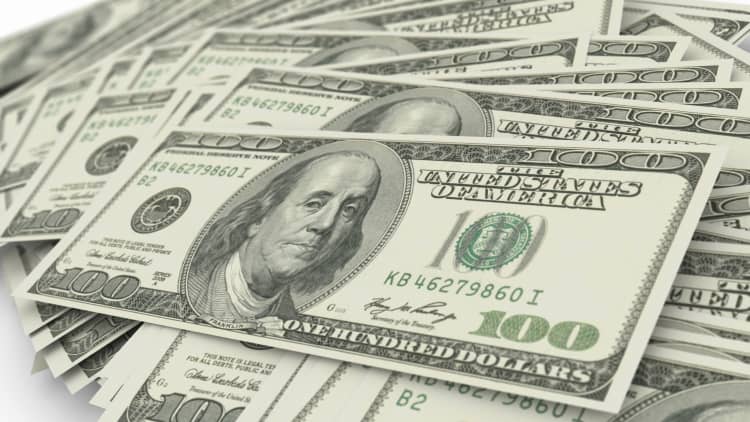


Investors will have at least one more month to worry about whether the Federal Reserve is raising rates.
In the face of jittery financial markets and a global slowdown, the Fed blinked and held its key federal funds rate unchanged. September was supposed to be the month the U.S. central bank finally came off its zero interest rate policy, but instead it opted to hold steady for at least one more month.
During a conference after the announcement, Federal Reserve Chair Janet Yellen stressed the path of the Fed's first rate hike in nearly a decade is more important than its timing.
(Click here for live updates of Yellen's conference explaining the decision.)
Following the decision, U.S. stocks were choppy as investors parsed Yellen's words for possible clues about rate timing and closed mixed.
Meanwhile, Treasury bond yields hit session lows, and safe-haven gold rose to highs not seen since September 4.
"One of the reasons for not hiking, I think, is that they didn't want to continue to increase the strength of the dollar, which would reverberate back into the United States," said Bill Gross, manager of the Janus Global Unconstrained Bond Fund.
RBS said the market is now pricing in the first full rate hike to occur in March, taking 2015 off the table.
Though giving a nod to an improving economy, with expectations slightly higher for gross domestic product and lower for the unemployment rate than three months ago, the Fed said low levels of inflation remain a problem.
"The committee anticipates that it will be appropriate to raise the target range for the federal funds rate when it has seen some further improvement in the labor market and is reasonably confident that inflation will move back to its 2 percent objective over the medium term," the Federal Open Market Committee post-meeting statement said.
The vote to keep rates at zero saw only one dissent, from Jeffrey Lacker who wanted to raise by a quarter point—a move seen on Wall Street as a virtual lock just a month ago until markets revolted. The statement gave no indication of how close the Fed is to instituting its first rate hike since June 2006. Rates have been at zero since late 2008 when they were slashed in the midst of the financial crisis.
Market watchers were struck both at the concern over inflation as well as the stress over the overseas problems.
"It makes it particularly difficult to gauge exactly when they think it would be appropriate to raise rates…because of how opaque (the situation in China and elsewhere) is," said Mark Zandi, chief economist at Moody's Analytics. "It's not clear to me exactly what we'll be able to look at or fix on when they will begin to raise rates."
In its economic projections, Fed members showed misgivings despite improvements in a number of areas.
The Fed has what is known as a dual mandate—price stability and maximum employment. The unemployment rate, currently at 5.1 percent, is well below the Fed's initial 6.5 percent benchmark for raising rates, but inflation, at least by the FOMC's favored gauges, has remained tame.
The "central tendency" for headline inflation, as gauged by the personal consumption expenditures index, is now at just 0.3 percent to 0.5 percent, down from an already-anemic 0.6 percent to 0.8 percent in June. Projections for core inflation, which excludes energy and food, held steady at 1.3 percent to 1.4 percent, well below the Fed's 2 percent target.
Concerns over the slow pace of inflation seemed to carry the day, as members adjusted their expectations for the pace of future rate increases.
One official on the 17-member FOMC even indicated that the appropriate time for the first rate increase wouldn't be until 2017. Thirteen members still see a 2015 hike, down from 15 in June, while three anticipate a 2016 move.
"We have to be worried now about what's happening in Asian equity markets and other places," said Jim Caron, fixed income portfolio manager at Morgan Stanley Investment Management. "If they lower their growth and inflation forecast, you have to weigh more heavily the possibility that the Fed will wait until 2016."
On Wall Street, the Fed's deliberations have been 2015's biggest drama.
Originally expected to hike rates in March, the Fed instead held at zero due to the low inflation rate and instability in the global economy, particularly in China. Financial markets have been volatile, with the major U.S. stock indexes tumbling more than 6 percent in August as market participants tried to read the Fed tea leaves.
In its statement, the FOMC confirmed it "is monitoring developments abroad.
"Recent global economic and financial developments may restrain economic activity somewhat and are likely to put further downward pressure on inflation in the near term," the statement also said.
The Street has tried to read between the lines of the central bank's policy statements, public speeches and projections.
Investors have had the phrase "dot plot" injected into their vocabulary, as Fed watchers scoured the map of individual members' expectations for the funds rate in the days and years ahead. That gauge on Thursday showed a slight drop for expectations since June on the funds rate—down 0.2 percentage points to 0.4 percent for 2015, the same decline for 2016 to 1.4 percent, and down 0.3 percentage points in 2017 to 2.6 percent.
Zero interest rates are a remnant of the Great Recession, during which the Fed sought to inject liquidity into a system shaken by a collapse in the financial world. In addition to the rate policy, the Fed conducted three rounds of bond buying known as quantitative easing, a program that pushed its balance sheet past $4.5 trillion and coincided with a more than 200 percent rise in the S&P 500.
However, economic gains have been harder to come by, with a senior official at the St. Louis Fed recently opining that QE did little or nothing to help the Fed achieve its goals.





